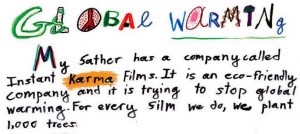For the start of Live Earth we have put together some of the latest thinking on making your production environmentally friendly. One company committed to the cause is Instant Karma – we spoke with co-founder Craig Farkas to find out what it costs to run a Carbon Neutral Shoot (and it is less than you think !)
Former vice-president, Al Gore, one of the organizers of Live Earth hopes this weekend’s concerts will be start along the road to all nations reducing greenhouse gases by 90 per cent by 2050.
The Live Earth concerts this weekend, which will be broadcast worldwide on television, satellite radio and the internet to reach more than 2 billion people, begin in Sydney and cascade around the world to Tokyo, Shanghai, Johannesburg, Hamburg, London, Rio de Janeiro and New York.
For the first time, China will participate. There are two special events: from Toji temple in Kyoto and from the British scientific base in Antarctica.
“The climate crisis requires a global solution,” said Kevin Wall – the man behind Live Aid and Live8 – and now this event. “Live Earth is using an unprecedented media architecture to reach a global audience.”
Gore says Live Earth will give people a chance to commit to changing their own lives and to moving others, including governments, towards a global treaty by 2009.
“Nations all over the world are making progress in tackling the climate crisis,” said Gore to the Sydney Morning Herald. “But too many proposals fall short of the strong, decisive action that’s needed. Individual nations alone cannot solve this crisis. The nations of the world must join together.”
If a cause is good enough to get Spinal Tap to reform then it has to be good!
As part of our Live Earth effort, fxguide looked at what we as a community can do, and spoke to a few people who have successfully incorporated carbon neutral strategies into the basic business plan.

Instant Karma Films has been carbon neutral since it launched last June. The company made a conscious decision to be a carbon neutral company, explains co-founder Craig Farkas, “but the environment was of concern to me since my childhood. I grew up in a high rise apartment building in Queens, New York and from my bedroom window I had the most incredible view of the Manhattan skyline. Every day I would watch the sun set over the city and the colors were spectacular.” Little did the young Craig know at that very young age that those colors were so spectacular due to the combination of auto exhaust and industrial pollutants spewing into the atmosphere. ” I remember the massive smoke stacks that continually released black smoke into the air. In those days there wasn’t much a child could do, but it was eternally etched into my memory and from high school I began my environmental advocacy”. Farkas started while at school with the Forestry & Conservation group he helped organized to help clean up the woods and streams surrounding his school, and his work continues today.
Instant Karma Films plants 1000 trees for each shoot they do, and as you can see below they have helped formulate the Carbon footprint of most standard American shoots.
fxg: do you think the film industry is aware right now?
CF: I believe most people in the film industry have an awareness of the environment but don’t know what they can do about it.
fxg: what sort of work do you do and what do you clients say/think ?
CF: We are a commercial production company. Our clients love the planting of 1000 trees for each shoot.
fxg: what practices on set or in post do you do differently ?- what practical things can productions do to be greener?
CF: We drive a hybrid and rent hybrids whenever possible. We have been trying to get the truck rental companies to convert some of their vehicles to bio diesel, same with the generators. We use set construction materials which are from sustainable resources and recycle everything. We attempt to run a paperless production but still find that most clients/agencies require a printed pre pro book but we are trying to change that and offer all materials online and provide everyone with a USB flash drive.
fxg:: what are some of the big ways our industry could improve?
CF: I wish I had the answer to that question but I don’t think there is any one big thing we can do. I think it is going to be the cumulative effect of everyone doing their small part that will make a difference. If everyone switched off lights or appliances that weren’t being used, changed light bulbs to high efficiency ones, drove a hybrid or carpooled. The list is long of what each and everyone of us can do to reduce our carbon footprint.
What you can do and how
10 ways to reduce your Carbon footprint:
1. Bottled Water
Europeans lead the world, but global demand has shifted from 28 to 47 Billion gallons in the last six years, but the lack of recycling bins means that many single serve empties get trashed. US drinkers alone toss 60 million plastic water bottles a day. If the carbon footprint of manufacturing and shipping the heavy bottles does not stop you, 16 ounces of bottled water costs more than a dollar (sometimes much more) vs less than a penny from a tap. Bottled water is a much bigger problem than paper cups, while it is great to reduce paper cup use… paper cups are shipped empty. Try just taking a marker on set and writing people’s names on their water bottles. And then just have a place to simply refill.
(source : National Geographic)
2. Couriers client review tapes
Courier costs are huge but so are the carbon footprint of making the tapes, and packing materials, and the courier van. It gets worse if your client review tape flies interstate. Companies such as Interdubs provide easy and effective online ways to allow clients and partners to review clips, ‘work in progress’ and final spots. An uncompressed full spot can now easily be transferred in minutes. www.interdubs.com
3. Shoot tape
With the advent of cameras such as the RED camera, think about shooting digitally and avoiding the carbon footprint of making, transporting, processing and developing thousands of feet of film. Film labs are as environmentally aware as they can be, but the chemical and power use of film is vastly more than that of digital. Better still, shoot direct to disc. The HVX 200 allows shooting directly to P2 cards or Firestore firewire drives – skipping expensive film and tape !
4. Recycle stock
Sony and other equipment manufacturers rate professional video stock as valid for THOUSANDS of dubs, yet in many post houses a new tape is used for all major client work. Not only is the tape expensive to buy, but the making, transporting, and storage of millions of Digital Betacam tapes has a large carbon footprint. Even a mini-dv tape should be fine to reuse 3000 times ! All you need to do is record black over them and then fast forward and rewind the tape. The ff and rwd process pulls in the slack of the tape and helps to get a seamless recording. Also aim to use just one brand of tape, and one that matches your gear.
5. Go digital
Avoid miles of callsheets, printed guides on expensive bleeched paper. Use more PDFs, quicktimes and Jpegs.
Put your reel on line. Or give out files to clients via USB key.
6. ichat
Avoid flying everywhere for meetings. One-way flight from New York to LA makes each passenger responsible for one ton of CO2 emissions. Of this most of the fuel – 25% is used on take off and landing, so if you must fly try just doing it on long hauls, and avoid short trips under 600 miles- and surprisingly one study shows that time of day matter and night time flights and night time contrails create more warming!
7. Turn it off
In many post houses Digital Betacams, monitors, and computers are not only left on 24/7 but they have no low power sleep mode. Try just turning off your gear when it is not going to be used. This will also decrease your MCR – equipment room, air conditioning bill – a major source of power consumption.
Set your office computers to sleep after a few minutes of inactivity and turn the Energy saving setting on you Mac on – in a standard production company this can save as much as $100 per year.
The US alone wastes over $1 billion a year on computer monitors that are turned on when they shouldn’t be. (source: Live Earth)
8. Use Lower power renderfarm processors.
Renderfarms use huge amounts of power and air conditioning. Lower Power consumption means lower heat and less expense plus less emissions. But computers are themselves very carbon expensive to make …. Your laptop is 5 times more energy expensive to make than a car or fridge! One two gram microchip creates two thousand times that amount of CO2
9.Give the client a lift
Literally travel with the client – it is always good to shmooze and reduce the amount of cars needed on set. If possible make some of the production cars hybrids. Companies like Enterprise Rent-a-Car rent Hybrid cars.
10.Make it part of business
A global survey by World Public Opinion taken in 2006 and published last month found that 43 per cent of Americans saw global warming as a serious and pressing problem that required urgent action. (And nearly 70% in places like Australia who have experienced a very long and sustained drought). Isn’t it just likely that your advertising clients would welcome knowing their Ad agency and TV ads are being environmentally carbon neutral?
The cost of buying carbon offsets for a typical shoot is less than most productions spend on Lattes and Mocha Frappuccinos.
(Source SMH)
The theory of Carbon offsets.
Reduce where you can and offset the rest.
Buying carbon offsets are easy, and can be make your production carbon neutral.
Some concern has been raised about carbon offsets, when Coldplay released its second hit album, A Rush of Blood to the Head, the band said that part of the environmental damage caused by its production would be offset by the planting of 10,000 mango trees in southern India. But according to the Telegraph newspaper in the UK, “More than four years after the album’s release, however, many of Coldplay’s good intentions have withered in the arid soil of Gudibanda, Karnataka state, where the saplings it sponsored were planted”.
Clearly the band’s intension was honourable, but not all Carbon Offset companies are equal and the poorly run ones threaten to hurt the entire sector.
Two valid carbon offset companies are the American Forests and Carbonfund.
American Forests is a world leader in planting trees for environmental restoration, a pioneer in the science and practice of urban forestry, and a primary communicator of the benefits of trees and forests. American Forests americanforests.org is the nation’s oldest nonprofit citizens’ conservation organization. Citizens concerned about the waste and abuse of the nation’s forests founded American Forests in 1875. The organization is proud of its historic roots in the development of America’s conservation movement and proud of the new approaches the organization has developed to help people improve the environment in the 21st Century.
Carbonfund is working with the Alliance for Climate Control, one of the organizers of the Live Earth Day. Carbonfund.org have calculators for working out your personal carbon footprint. Carbonfund reduces the threat of climate change by making it easy and affordable for any individual or business to reduce their carbon footprint and support climate-friendly projects. With its easy-to-use calculator, low offset cost per ton of CO2, and certified offset projects, Carbonfund.org is allowing anyone to reduce their impact on climate change easily and efficiently. Carbonfund.org is a 501(c)(3) nonprofit business, and a member of the EPA’s Green Power Network, the Chicago Climate Exchange, and Ceres.
What is the Carbon footprint of a film shoot?
Carbonfund has partnered with Instant Karma films, to assess the carbon emissions from producing commercials, and provide an easy way to offset those carbon emissions to make your new commercial carbon neutral with Carbonfund.org’s Carbonfree program.
Participation in the Carbonfree program gives you access to their branding, logos, and outreach materials. The idea is that when consumers see the Carbonfree logo, they know your production company is taking responsibility for its carbon emissions. You receive a certificate which denotes the number of tons that you offset, and we can also develop customized programs for your internal audiences or external clients.
Carbonfund have worked out with Instant Karma Films the following calculations:
1-2 Day Shoots – $280 (51 metric tons of CO2)
3-4 Day Shoots – $380 (69 metric tons of CO2)
* based on US$5.50 per ton offset costs.
If you have an unusual situations (lots of talent, unique location, etc.), you can contact them directly and they will provide a customized calculator and staff assistance to arrive at the precise calculations to offset your commercial project.

Note:
fxguide is now a Carbon Neutral Organization, we have moved some of our cars to hybrids, we are now promoting less use of wasteful items such as bottled water and a more tapeless and paperless workflow. We are recycling tape stock and all our new shoots, productions and travel are being offset by Carbon Offsets.
We will continue looking for more ways to improve in coming months.


